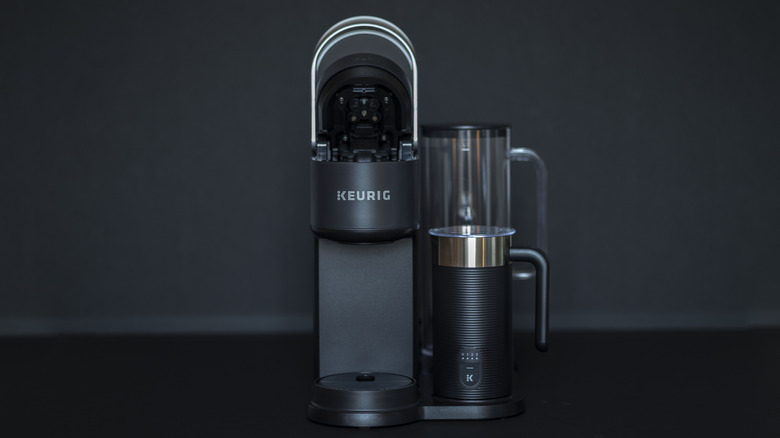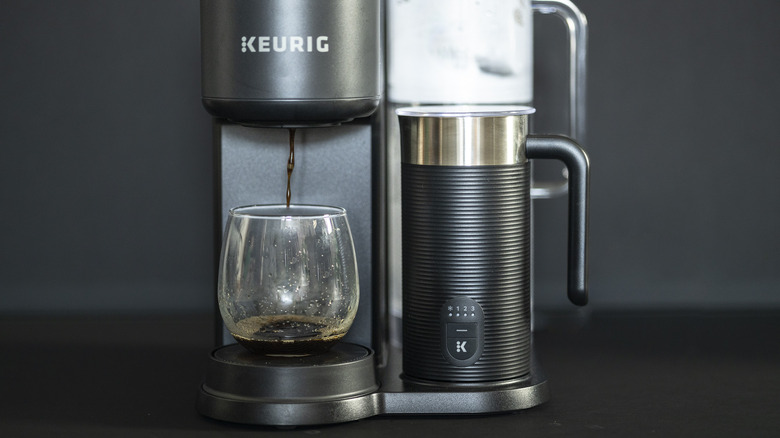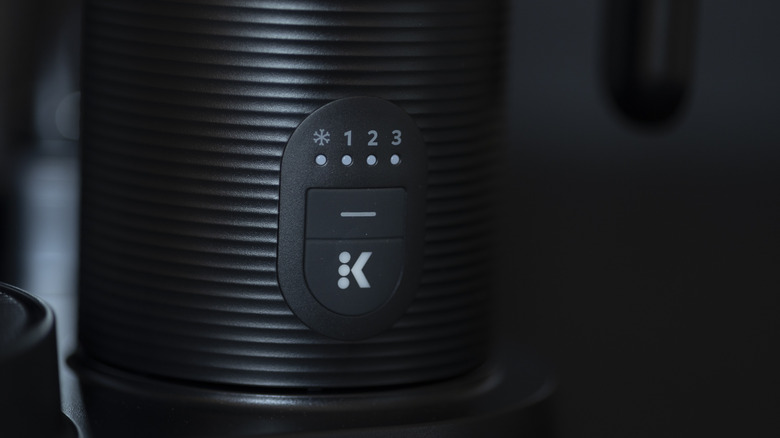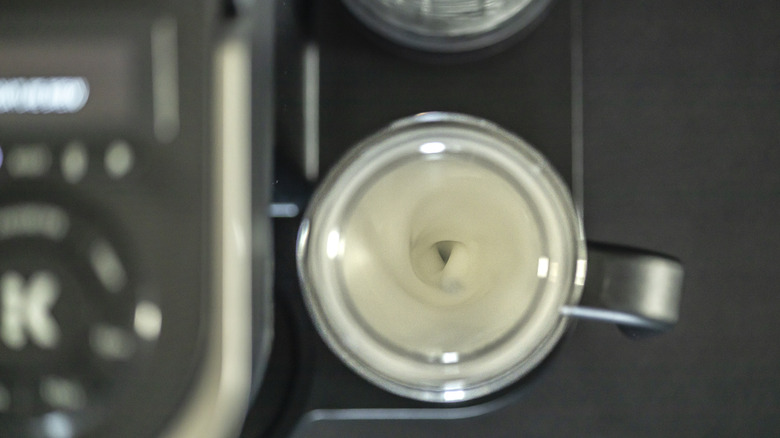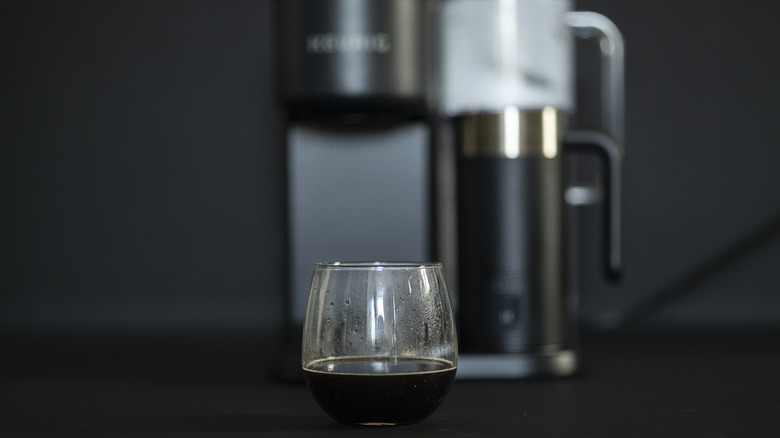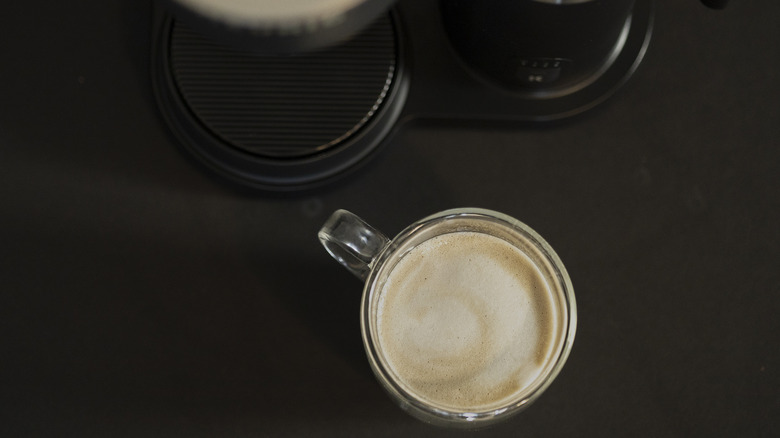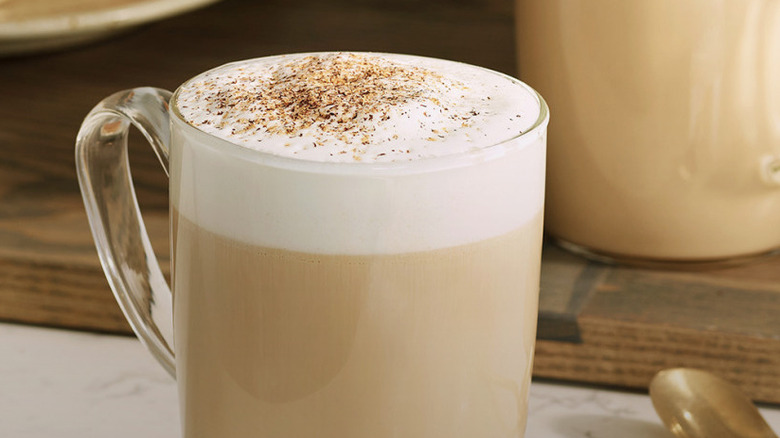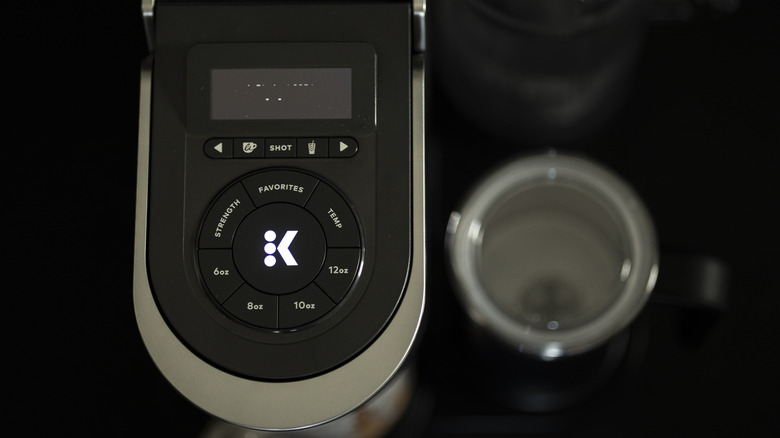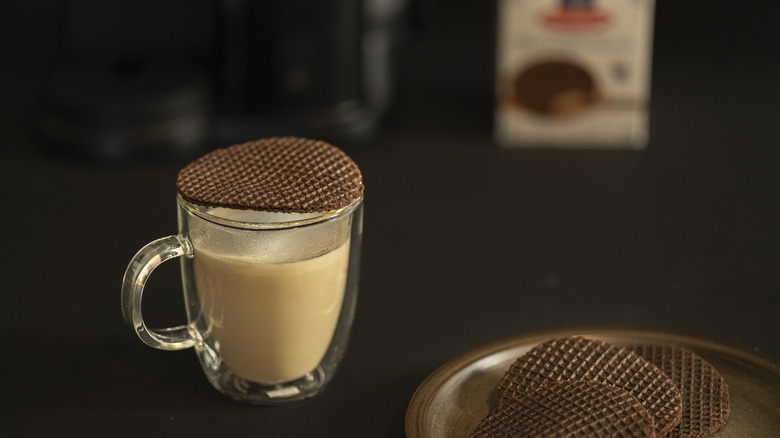Review: Is The Keurig K-Cafe SMART Worth It?
Recently, Keurig announced its most intelligent brewer yet: the K-Cafe SMART Single Serve Coffee Maker, the second machine in Keurig's lineup of connected at-home brewers. It follows behind the Keurig Supreme Plus SMART brewer and adds several new functions, including the hot/cold milk frother and Keurig's Barista Mode.
The at-home brand has come a long way since its first model hit markets decades ago, but we want to know if these emerging smart models do anything to help fix the fundamental issue with the pod approach to preparing the beverage — the issue that a predetermined amount of coffee grounds shouldn't be used for varying amounts of water. Let's explain: Six ounces of coffee requires a different weight of grounds than 8 ounces and 10 ounces. When passing 10 ounces of water through the number of grounds meant for a 6-ounce cup, your coffee runs the chance of being over-extracted — and under-extraction with the vice versa. Some coffee lovers may feel that pod-style coffee is never strong enough; coffee pods contain around 12 grams of coffee at most (via Coffee Affection), while Custom Cup Coffee recommends around 18 grams for a single 8-ounce pour-over.
Is technology enough to counteract this foundational issue? Are we doomed to always make flavor sacrifices for convenient coffee, whether it be for pods or instant coffee? Do you need a bigger, better, "smarter" Keurig? We explored one to find out.
Cost, availability, and what's in the package
The K-Cafe SMART Single Serve Coffee Maker is currently only available through Keurig's website, with plans for expansion into stores sometime this fall, according to Keurig. The machine's MSRP is $249.99, but a 50% discount may be available by purchasing a Keurig Starter Kit. The kit, and thus the K-Cafe SMART discount, requires the purchase of four boxes of pod products and a commitment to purchasing 16 boxes of pods over a calendar year via auto-shipments.
Upon opening your K-Cafe SMART brewer package, you'll find the machine's quick start and maintenance guides, a pamphlet for the Keurig app, and a couple of coupons — ours were for McCafe, Donut Shop, and Green Mountain coffee pods, and a container of Keurig descaling solution. There's a small item in the mix that you'll want to be sure to set aside — it's the water filter and instructions for installation of the filter. The box will also contain the brewer itself, its runoff/spillage tray, a water reservoir (which expands on the more convenient pitcher-like style of a reservoir that's emerged in newer models and makes it distinctly separate from the machine for easier access), and a milk frother.
How to use the Keurig: Setup and first use
You'll first open up the quick start guide and locate the first step. There are only four steps in the guide, but it will take much more exploration than that to get fully familiar with the machine. The first thing Keurig prompts users to do is scan the QR code on the back of the machine to download the Keurig app, but we actually recommend reading the water filter instructions first. The filter must be rinsed and soaked for five minutes, which wasn't mentioned in the start-up guide and held us up later on.
If you don't already have one, the Keurig app will prompt you to make an email-based account. Once the app is downloaded, an account is made, and the brewer is plugged in, the app will lead the user through a series of simple steps to connect the brewer and app, then the brewer and Wi-Fi. We found this process incredibly user-friendly, as most of it takes place on your phone and not the small display screen on the Keurig. The back of the guide provides a few housekeeping things that need to be done before brewing can commence: The reservoir should be rinsed and filled, the frother should be cleaned and dried, and the machine should undergo a cleansing brew, which the user will be prompted to do once the machine is on and connected anyway. After the cleansing cycle is complete, you're ready to start brewing.
How to use the Keurig: brewing features
There's a lot to explore on the K-Cafe SMART, but you must be fully set up (connected to Wi-Fi, app downloaded) to do it. A pod must also be loaded into the machine to toggle through the settings. There isn't any guidance in learning the display from the material in the machine's package, so users must rely on trial and error to get familiar with it — the product support videos in the app are currently limited to frothing and descaling. The icons on the brewer's display indicate three types of brews: signature brewed coffee, single or double shots meant for lattes and cappuccinos, and iced coffee.
The main feature of the display is the large Keurig logo; this button is to start brewing. The temperature can also be changed between six settings with the temp button: warm, warmer, hot, hotter, X-hot, and max hot. We tried a coffee on warm versus the signature brew default settings, and there was a discernible difference (signature brew is hot enough to need a few minutes of cooling). The strength of the brew has five settings and can be changed on the machine with the strength button: balance, rich, robust, strong, and intense. When selecting the signature brew button after strength and temperature are picked, the machine overrides the customization and brews on a predetermined setting meant for drink optimization, allowing the user to pick the size of the coffee between 6, 8, 10, and 12 ounces.
How to use the Keurig: the frother
The frother is the black pitcher that comes in its own smaller box within the Keurig packaging. It has two basic settings: hot and cold froth. Toggling between the two might be confusing at first because we think the two buttons on the frother could have been a bit more distinguished from each other, but the upper, smaller button with the horizontal line will switch the frother's function between cold (the leftmost indicator light with a snowflake design) and the three settings of hot. The one, two, and three numbers indicate levels of froth or the ratio of bubbly foam to milk. The No. 1 setting is the least amount of foam, equivalent to a latte. The middle No. 2 setting makes a moderate amount of foam that was close to a wet cappuccino. An indicator light will glow on whichever setting is selected — blue when on cold, red when on hot froth settings — and the lower button with the K logo will run the frothing cycle.
The machine cannot run its brew and frothing functions at the same time, so if you attempt to start a brew while frothing is occurring, the brewer will inform you that the coffee will be made when the frother is finished. The frother is easy to use and significantly elevates at-home craft coffees, although not to the degree that a steam wand would.
Coffee taste: black coffee
So what difference does a machine like this make in the quality and taste of coffee it's producing compared to other Keurigs? We feel Keurig made an earnest attempt to address one of the most important foundational elements of its machines — how well it brews a classic cup of black coffee — with its Brew ID technology. With this feature, the brewer can detect the brand and roast of the pod that's being brewed and will update the temperature and water flow of the brew based on the coffee roaster's recommendations.
But water moves through pods in a hurry, so what about the weight-to-water ratio issue, and over- or under-saturation? Keurig states that the new brewer continues on the five-needle entry points into the pods — many older and/or smaller machines have just one, but the K-Supreme Plus SMART has five. The company calls it "multi-stream technology." Five entry points into the pod allow for more saturated coffee grounds, rather than the lone stream tunneling through the grounds. Keurig also installed pressure controls in the new model, so the water can pass through grounds in varying forces for lighter or stronger extractions.
We blind taste-tested a Green Mountain Dark Magic dark roast as a signature brew from the K-Smart and a freshly-brewed pour-over of the same brand and roast using bagged grounds, and we couldn't tell the difference. That's a win for Keurig after we've experienced our fair share of weak, sour, under-extracted pod-style coffees.
Coffee taste: lattes, cappuccinos, and more
Here's the number-one reason to consider a K-Cafe SMART for your home: its cafe-style capabilities. The brewer is meant to make espresso-like shots out of regular coffee pods by forcing a smaller amount of water through the grounds at a higher pressure, which is something we feel the machine does well when making casual lattes at home, although those who enjoy espresso alone or even espresso con panna will long for the silky crema you only get with espresso-style roasts and dedicated espresso machines. These shots taste more like very strong brewed coffee (which is what it is).
It's key to understand the difference between steamed and frothed milk so you have realistic expectations when preparing your first drink with the machine. The former is made by heating milk with a wand that emits pressured steam; the milk is injected with tiny bubbles, called microfoam, giving lattes that velvety texture. Steamed milk is less voluminous but has a thicker mouthfeel. Frothing, on the other hand, creates a more cloud-like foam that, while light and airy, dissipates quicker. Frothing works for cappuccinos, but steaming is considered best for lattes. While we did get that pillowy layer of foam on the lattes we made, the milk incorporated into the drink was noticeably different texture-wise than a true barista-made latte.
The machine does well at wet cappuccinos and 50/50 cappuccinos but its three frother cycles don't make enough foam for a dry or bone dry cappuccino.
K-Cafe SMART and the Keurig app
The Keurig app is critical to success with the K-Cafe SMART, and if you take any advice from us, let it be that you should explore everything the app has to offer before even making a basic coffee. There's no guide material for the app, so it's on you to get familiar with the resource. If you try to dive into the K-Cafe SMART without knowing the app, you may feel overwhelmed.
The brewer's remote settings — that is, its capability to turn the machine on and initiate brews — will prove to be utterly invaluable or entirely useless depending on your lifestyle and needs. Scheduling brews only seems convenient for plain coffees, since it's impractical and inadvisable to load milk into the frother and leave it at room temperature until you need it. Even if you never touch the scheduled brew, however, a trove of other tools waits, the most significant of which being Café Creations and Brew ID.
"After you brew a cup of coffee, [Brew ID] will give you recipe recommendations that are perfect for that pod," explains Keurig VP of Keurig Experiences Annie Oh. "So, let's say you brew Peet's Major Dickason's. When you go into your app, you'll see a series of recipes that pair very well with that pod."
Café Creations is a collection of over 70 recipes. The recipes are ridiculously accommodating, giving step-by-step instructions and product recommendations.
The app's greatest shortcoming is its support videos — there are two.
K-Cafe SMART vs other Keurigs
The K-Cafe SMART has the most bells and whistles. However, it'll be up to you to decide if the features are worth the extra $100 investment from the K-Café Single Serve Coffee, Latte, and Cappuccino Maker. It doesn't have smart capabilities but holds the same amount of water, and can make the same specialty drinks.
We also have to give the Keurig K-Select Coffee Maker a shot at a comparison, since it has a large reservoir, has more than one strength setting, and employs Quiet Brew Technology, which the K-Cafe SMART's product information doesn't mention — all for less than $150. If you're a coffee drinker who likes what they like — regular coffee and no fancy milk — all you need is the K-Select. We also had one instance of the machine's pod-reading technology believing that the loaded pod was used, when it was brand new, but we're blaming that on the not-yet-up-to-date software.
Like other Keurigs, this one can use on- or off-brand coffee pods, doesn't require Wi-Fi to operate, and needs a consistent maintenance schedule. One thing you must know about Keurigs, especially this one, is proper maintenance is necessary if you want the machine to work without issue. The frother should be thoroughly rinsed immediately after each use — caked-on milk residue would be something you do not want to deal with, and since the frother can't be submerged due to its electrical contacts, soaking may be a hassle.
Is the K-Cafe SMART worth it?
Does your grandma who's still rocking her single-serve Keurig from 2010 need the K-Cafe SMART for Christmas? We have to say, probably not. Keurig has a wide array of models that appeal to the coffee lovers that don't have many asks, and we think there are many demographics and lifestyles that the suite of "smart" features Keurig is slowly rolling out just won't hold any appeal for. We also think that there's an opportunity for more introductory guidance for the average consumer when the K-Cafe SMART is first being unboxed and brewing its first brews since there was a lot that we had to seek and understand on our own.
However, the perfect K-Cafe SMART owner certainly exists. Oven-baked French fries aren't the same as a hot order from a fast food joint. A canned root beer just isn't the same as one flowing from a tap. And, just the same, lattes and cappuccinos just seem to be a little sweeter when they're handed to you by a smiling barista. But with the user-friendly frother, artisanal drink recipes, and auto-ship coffee pod service, Keurig has come up with something special for java drinkers that are explorative with their coffees, particular about their morning routines, or just want to save a few minutes — and a few bucks — by skipping the coffee drive-through each day.
